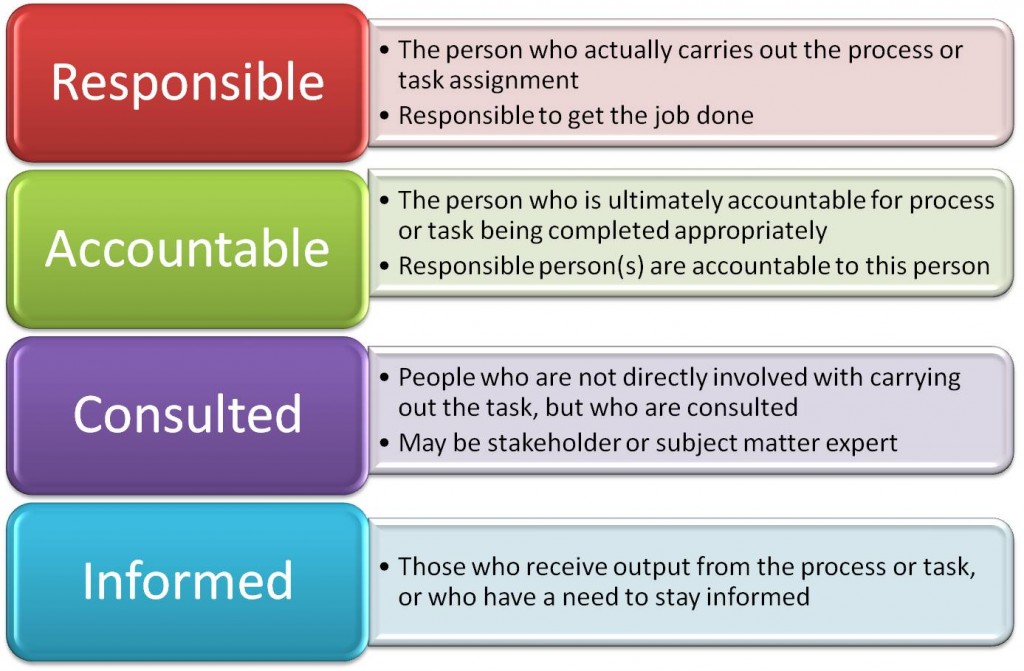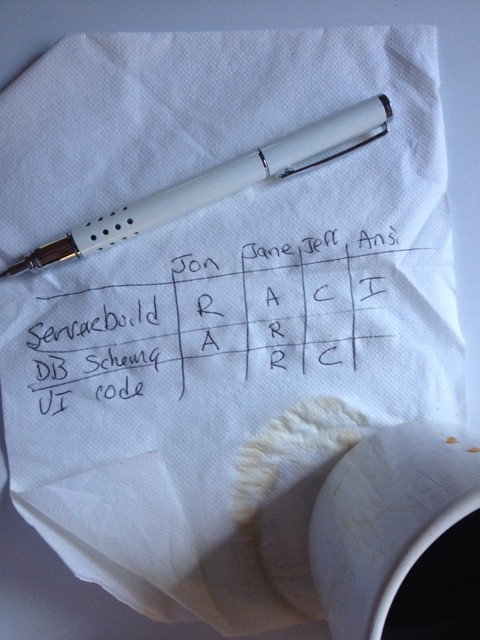Misunderstandings make for good TV entertainment, but in ITSM, it’s not so funny. A RACI chart is a quick and easy way to create clarity.
I have no clue who first created the RACI chart, but like most common sense, it likely was born out of necessity. I picture a struggling team trying to figure out what’s going wrong. They talk over coffee and slowly realize they’re all thinking “I thought I was doing that”, or “I thought you were….”
So, on a paper napkin they sketch out a table of tasks to be done, and members to do them. For each task, they mark the roles each will play.
Thus was born one of the most powerful, and yet simple tools to create clarity in roles and responsibilities.
RACI, not Racy
So how can a RACI chart (or ‘matrix’) help?
Well, for starters, it’s simple. It can be drawn out over a cup of coffee with no need for technology or in depth analysis. In essence, it facilitates conversation about roles and responsibilities, and draws out unspoken assumptions.
It’s simply a list of tasks along the left side and columns of key stakeholder (either names or roles) across the top. At the intersection, responsibilities are assigned. The choices are: Responsible, Accountable, Consulted, and Informed. (Hence ‘RACI’)
 But don’t let the simplicity fool you. The power is exactly that – simple to create, huge benefits in clarity and efficiency. The proverbial bang for the buck!
But don’t let the simplicity fool you. The power is exactly that – simple to create, huge benefits in clarity and efficiency. The proverbial bang for the buck!
Let’s take a look at RACI in action.
Creating a RACI Chart
You can easily create a RACI chart in a spreadsheet. There are hundreds of templates on the Internet (or download my free Basic RACI Chart Template.)
Then:
- List tasks along the left hand column
- Identify key stakeholders across the top
- Discuss and agree to roles/responsibilities (R/A/C/I)
- Once agreed, assign roles at the matrix intersections
The only hard and fast rule for role assignment is that each task can only have one accountable role. This shouldn’t be ignored or taken lightly. Discussion about who’s ultimately accountable can reveal differences of opinion (source of confusion) and begin the process of creating clarity.
If you struggle to agree to just one accountable person, you may have your tasks at too high a level. (“world peace”, “happiness”, etc.) Break tasks down further until a logical accountable person for each becomes clear.
Next, identify who’s responsible for accomplishing the task or process.
It’s common to have more than one responsible role. But if you find yourself assigning lots of ‘responsible’ people, your tasks may be too low level.
Consulted can be a tricky role. Consulted means having critical knowledge, experience, or information necessary to successfully carry out the task, but does not actually do the work of the task. Be sure to keep a clear distinction between responsible and consulted.
Roles are not cast in stone. With the agreement of the stakeholders, they can be adjusted as needed. RACI charts are a perfect reference point when disagreements arise, and help facilitate healthy dialogue.
Perhaps an example we can all relate to.
A Quick Example
The family trip. A feat of complex logistics by itself, compounded by the fact that, well, if something is forgotten, everyone’s vacation will be ruined.
Packing suitcases. Everyone for themselves seems reasonable, but we all know what really happens. When you get there without a toothbrush. Mom!!!! So, in reality, Mom’s ultimately accountable for suitcase packing. That being the case, as accountable, she has the right to ask ‘did you pack your toothbrush?’ Everyone else is then responsible to pack their own.
toothbrush. Mom!!!! So, in reality, Mom’s ultimately accountable for suitcase packing. That being the case, as accountable, she has the right to ask ‘did you pack your toothbrush?’ Everyone else is then responsible to pack their own.
Likewise (gender stereotypes be cursed) dad’s accountable to make sure the car is full of gas. But, let’s say Mom stops to get gas on the way home while dad’s packing. Dad’s still ultimately accountable, but Mom has taken responsibility for actually getting it done. The kids are informed.
Loading the right beach toys is a big deal. To the kids, the whole vacation is ruined by a toy mistake. Dad takes accountability, and each kid is responsible to get the right ones. But here mom is consulted, because she knows what works and what doesn’t. (“Mom, do you think we should bring the red bucket? The handle is broken, but I like it for sand castles.”)
Notice on the cabin reservation, Sarah is consulted. Last year she made an inventory of the “best cabins for next year”. Dad’s still responsible and Mom accountable, but her input is wanted.
Making it work
Making a RACI chart is a quick and painless way to increase clarity. Many organizations use them proactively when developing processes or project plans. RACIs accelerate delivery by avoiding unnecessary discussions and disagreements.
Things to keep in mind:
- Engage all stakeholder when creating
- Multiple accountable = too high level tasks
- Many responsible = too low level tasks
- One task, one accountable
- Consulted = information and expertise; not working task
- Informed = input not required; not working task. Kept informed
How have you found RACI charts helpful? What tips would you add for making them work in real life situations?



4 comments on „What’s a RACI Chart and how do I use it?”
Comments are closed.